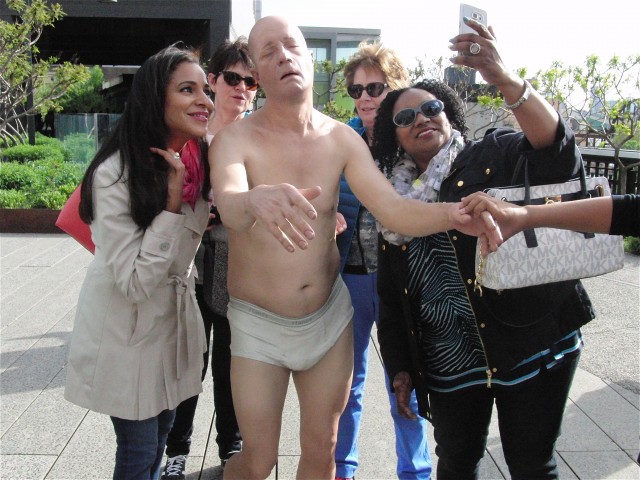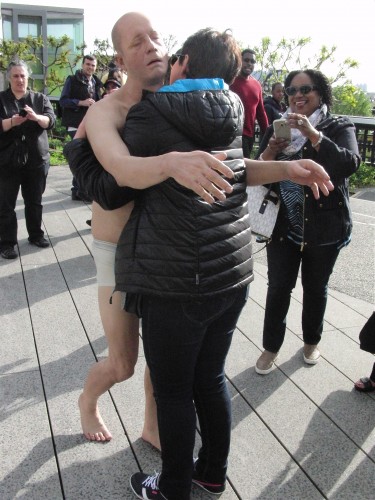
A group of women pose with Tony Matelli’s “Sleepwalker” on the High Line (photo by twi-ny/mdr)
The High Line
Eleventh Ave. from 34th St. to Gansevoort St.
“Wanderlust” through March 17, 2017
Open daily, free, 7:00 am – 11:00 pm
www.thehighline.org
sleepwalker high line slide show
It’s all about context. In June 2014, there was a furor at Wellesley when students at the all-woman college protested against the installation of Tony Matelli’s “Sleepwalker” sculpture, a lifelike rendering of a bald white man in nothing but his tighty-whities, eyes closed and arms outstretched. While he is meant to be in the midst of harmless somnambulation, hundreds of women signed an online petition that claimed that the work “has become a source of apprehension, fear, and triggering thoughts regarding sexual assault for some members of our campus community”; others playfully mocked the work, creating virtual images of it dressed in school T-shirts and the like. Matelli responded by telling CBS Boston, “I think that these people are misconstruing this work. I think they’re seeing something in this work that isn’t there. But who am I to say how people should react to this?” Ultimately, the statue had to be removed after being spray-painted and subsequently broken in protest. A few months later, I encountered a different casting of “Sleepwalker” on the rooftop deck of the Marlborough Chelsea, where it was just him and me; at the time, I wrote that I found it to be “intriguing and humorous, not threatening at all, perhaps even symbolic of an America that often seems to be half asleep.” Of course, I’m not a college-age woman, and the sculpture is not by the side of the road in some woods.

Tony Matelli’s “Sleepwalker” gets a hug from a happy stranger on the High Line (photo by twi-ny/mdr)
“Sleepwalker” has now made its way to the High Line, where it awaits visitors by the Fourteenth St. entrance as part of the group show “Wanderlust.” On a recent Saturday afternoon, I watched as people huddled around it, many wondering if it were an actual real person, waiting for him to make a sudden movement. Kids reached out to touch a hand, a young man sniffed its head, and tourists posed in silly positions with the work. There were hugs, funny faces, selfies, and an abundance of smiles after initial hesitation. At Wellesley, “Sleepwalker” was steeped in controversy. At the Marlborough Chelsea, it was somewhat of a lonely, pathetic creature. And now, on the High Line, one of the city’s most attractive destinations, it has become a novelty; there was even an official photo contest on April 23 “inviting visitors to the park to post their most creative photo inspired by Tony Matelli’s sculpture ‘Sleepwalker.’” It’s a far cry from the spray-painted version surrounded by police tape on the Wellesley campus. Art affects people in different ways, and “Sleepwalker” is a stunning example of that. It also says a lot about where we are as a culture in the twenty-first century.